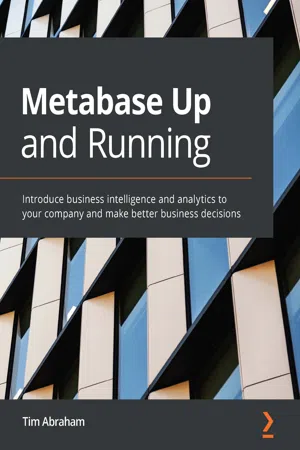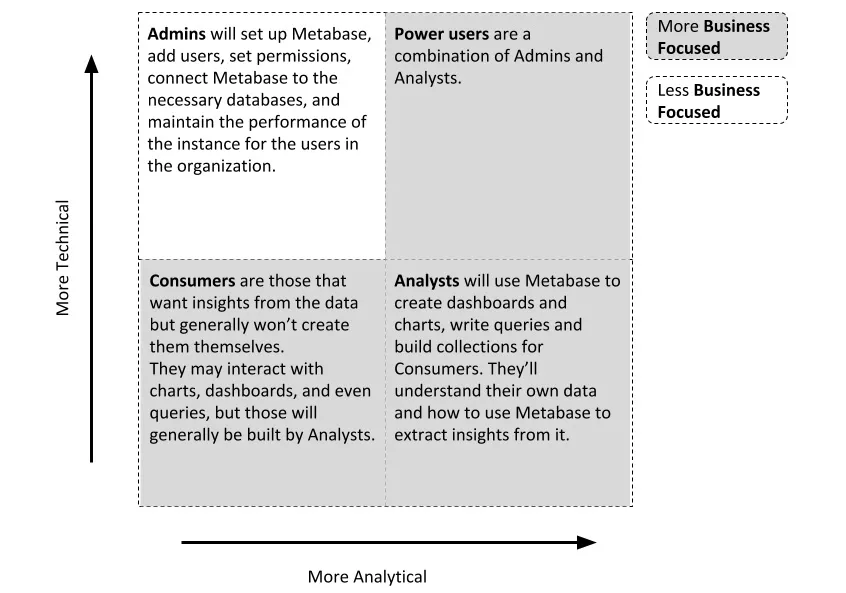
Metabase Up and Running
Introduce business intelligence and analytics to your company and make better business decisions
- 332 pages
- English
- ePUB (mobile friendly)
- Available on iOS & Android
Metabase Up and Running
Introduce business intelligence and analytics to your company and make better business decisions
About This Book
Ask questions of your data and gain insights to make better business decisions using the open source business intelligence tool, Metabase
Key Features
- Deploy Metabase applications to let users across your organization interact with it
- Learn to create data visualizations, charts, reports, and dashboards with the help of a variety of examples
- Understand how to embed Metabase into your website and send out reports automatically using email and Slack
Book Description
Metabase is an open source business intelligence tool that helps you use data to answer questions about your business. This book will give you a detailed introduction to using Metabase in your organization to get the most value from your data.
You'll start by installing and setting up Metabase on your local computer. You'll then progress to handling the administration aspect of Metabase by learning how to configure and deploy Metabase, manage accounts, and execute administrative tasks such as adding users and creating permissions and metadata. Complete with examples and detailed instructions, this book shows you how to create different visualizations, charts, and dashboards to gain insights from your data. As you advance, you'll learn how to share the results with peers in your organization and cover production-related aspects such as embedding Metabase and auditing performance. Throughout the book, you'll explore the entire data analytics process—from connecting your data sources, visualizing data, and creating dashboards through to daily reporting.
By the end of this book, you'll be ready to implement Metabase as an integral tool in your organization.
What you will learn
- Explore different types of databases and find out how to connect them to Metabase
- Deploy and host Metabase securely using Amazon Web Services
- Use Metabase's user interface to filter and aggregate data on single and multiple tables
- Become a Metabase admin by learning how to add users and create permissions
- Answer critical questions for your organization by using the Notebook editor and writing SQL queries
- Use the search functionality to search through tables, dashboards, and metrics
Who this book is for
This book is for business analysts, data analysts, data scientists, and other professionals who want to become well-versed with business intelligence and analytics using Metabase. This book will also appeal to anyone who wants to understand their data to extract meaningful insights with the help of practical examples. A basic understanding of data handling and processing is necessary to get started with this book.
Frequently asked questions
Information
Section 1: Installing and Deploying Metabase
- Chapter 1, Overview of Metabase
- Chapter 2, Hosting Metabase on AWS
Chapter 1: Overview of Metabase
- Introducing Metabase
- Metabase's origins
- Why open source?
- Installing Metabase locally
- Installing and deploying Metabase via the cloud
Technical requirements
Introducing Metabase
Finding answers in your database

Who should use Metabase?

- Admins make sure Metabase is up to date and running smoothly. They are the ones who install Metabase and give everyone a login. It is the admins' responsibility to make sure that other users can view the sales numbers, but they will probably not have to pay attention to the numbers themselves.
- Consumers are people whose jobs are closely tied to the sales numbers, but may not be technical enough to produce a chart on their own. While they don't normally make the charts themselves, they are able to easily click around and edit a chart for their specific use case. For example, a consumer who is responsible for business in California is able to filter the chart to show only sales in California.
- Analysts are those who have a deep understanding of data, including metrics, statistics, and databases. They are close to the business but perhaps not as close as some consumers, who they consider the...
Table of contents
- Metabase Up and Running
- Why subscribe?
- Preface
- Section 1: Installing and Deploying Metabase
- Chapter 1: Overview of Metabase
- Chapter 2: Deploying Metabase with AWS
- Section 2: Setting Up Your Instance and Asking Questions of Your Data
- Chapter 3: Setting Up Metabase
- Chapter 4: Connecting to Databases
- Chapter 5: Building Your Data Model
- Chapter 6: Creating Questions
- Chapter 7: Creating Visualizations
- Chapter 8: Creating Dashboards, Pulses, and Collections
- Chapter 9: Using the SQL Console
- Section 3: Advanced Functionality and Paid Features
- Chapter 10: Advanced Features, Getting Help, and Contributing
- Other Books You May Enjoy